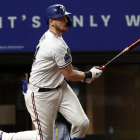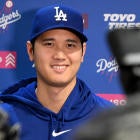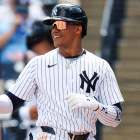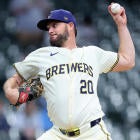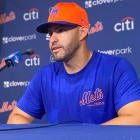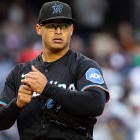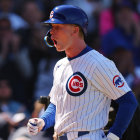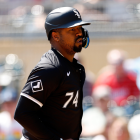
The arrival of the offseason means that it's time to rank stuff. Already this winter, we've sized up the 60 best free agents, both on an overall and positional basis. There's no law that prevents us from ranking minor-league players in addition to their big-league counterparts. As such, we're going to spend the winter evaluating every team's farm system.
The lack of a minor-league season makes that more of a challenge this year. It doesn't help that some teams opted against sharing video and data from their alternate-site camps with the rest of the league. As such, we've opted against overthinking this. Our rankings will essentially be the same as they were last winter with a few changes. First, we'll exclude anyone who graduated by exhausting their rookie eligibility; second, we'll replace them with draftees or other worthy prospects; and third, and lastly, we'll present the information in a new format.
In every article in this series, you'll find a team's top five prospects as well as five others we felt like including, either because of their promise or some other reason. For those top five prospects, you'll find a quick summation of their pros (their saving grace, if one will) and their cons (their fault line), as well as beefier report and our attempt to peg their "likeliest outcome."
These rankings were compiled by talking to industry folks -- scouts, analysts, and other evaluators -- and include a touch of our own evaluative biases. Remember, that this is more of an art than a science, and that the write-ups matter more than the rankings themselves.
Now, let's get on to the top five prospects in the Texas Rangers system.
1. Josh Jung, 3B
Age (as of 4/1/2021): 23
Height/Weight: 6-foot-2, 215 pounds
Acquired: Eighth pick in the 2019 draft (Texas Tech)
Highest level: A-ball
Saving grace: Polish
Fault line: Carrying tool
Scouting report: Despite being selected eighth overall, Jung (it's pronounced "young") was the fourth collegiate bat off the board in 2019. Based on that sentence, you might suspect that he's a polished hitter who is reasonably likely to remain at his position; true on both accounts. What you might not guess is that he could lack a carrying tool unless he's able to maximize his offensive output by tapping into his raw power. Should Jung fail in that pursuit, he'll have a handful of averageish tools, which isn't the worst-case scenario -- that would entail his power playing so light as to diminish his potential to hit for average and walk at a high clip.
Likeliest outcome: Some approximation of Chase Headley
2. Sam Huff, C
Age (as of 4/1/2021): 23
Height/Weight: 6-foot-5, 240 pounds
Acquired: Seventh-round pick in 2016 draft (Arcadia High School, Arizona)
Highest level: MLB
Saving grace: Power, framing
Fault line: Hit tool
Scouting report: The Rangers treated the final stretch of their season as an audition stage for some of their better young players, even if that meant skipping them over several levels to make it happen. That process included Huff, a 2019 pop-up who hadn't appeared above High-A. Think of Huff as Mike Zunino's spiritual statistical successor. When he's at the dish, he's going to strike out a ton, walk infrequently, and put an absolute charge into the pitches with which he connects; when he's behind the dish, he's going to show off a good arm and above-average framing ability. The wrinkle with Huff is that he's much larger than Zunino, to the extent that there'll be concerns about his viability back until he's graying or moved off the position; the latter would put a considerable dent in his chances of being rosterable until the former.
Likeliest outcome: Slug-and-glove backstop
3. Leody Taveras, OF
Age (as of 4/1/2021): 22
Height/Weight: 6-foot-2, 195 pounds
Acquired: International amateur free-agent signing
Highest level: MLB
Saving grace: High-grade defense
Fault line: Lower-grade bat
Scouting report: As with Huff and some of the others featured below, the Rangers responded to the pandemic by pushing Taveras to the majors before he'd even recorded 300 at-bats in Double-A. The results, then, don't much matter unless they validate preexisting beliefs. What actually matters is that Taveras is a dynamic athlete who should be a well-above-average center fielder and baserunner for years to come. (One stat that we will note: he went 8 for 8 on stolen-base tries, a marked improvement over the 11-for-19 effort he posted in 2019.) The development of Taveras' bat -- specifically his ability to tap into his raw power -- will dictate if he's a star-caliber player or a bottom-third hitter who earns his living with his defense.
Likeliest outcome: Glove-first center fielder
4. Justin Foscue, INF
Age (as of 4/1/2021): 22
Height/Weight: 6-foot, 203 pounds
Acquired: 14th pick in the 2020 draft (Mississippi State)
Highest level: NCAA
Saving grace: Offensive polish
Fault line: Defensive ability
Scouting report: Foscue was in greater demand within the industry than it seemed from the outside, with league sources confirming that he would have been selected within the top 20 even if the Rangers had not popped him at No. 14. He isn't going to win any footraces or Gold Glove Awards, but he should develop into a quality hitter who can stand at either second or third base. Foscue commands the strike zone and he has a good feel for contact. He didn't showcase much over-the-fence power during his time on campus, yet his above-average exit velocities suggest there might be room for growth in that regard.
Likeliest outcome: Bat-first infielder
5. Cole Winn, RHP
Age (as of 4/1/2021): 21
Height/Weight: 6-foot-2, 190 pounds
Acquired: 15th pick in the 2018 draft (Orange Lutheran High School, California)
Highest level: A-ball
Saving grace: Youth, athleticism
Fault line: Less-than-ideal pro introduction
Scouting report: The book on Winn coming out of Orange Lutheran (the same school that produced Gerrit Cole, suggesting they're not an eco-friendly place) had him down as a polished strike-thrower with a potential four-pitch mix. Winn then partook in the Rangers' "deloading" program, delaying his debut until 2019 … when he walked more than a batter every other inning. Oops. Winn did improve his walk rate after the first month, but his progress entailed issuing free passes to 11 percent of the batters he faced. (For reference, Martin Perez had the majors' highest walk rate among qualified starters in 2020, at 10.7 percent.) That is, to state the obvious, not what you want from someone who was supposed to be a relatively "safe" high-school arm. Time is on his side, so feel free to store your towels for at least a little while longer.
Likeliest outcome: Mid-rotation starter
Five others to know
Anderson Tejeda, MIF
A shoulder injury limited Tejeda to fewer than 50 games in 2019, which likely made his leap from High-A to the majors last season all the more disorientating. Nevertheless, Tejeda's big-league run wasn't a disaster. He hit the ball hard when he made contact, and he showed off his range, athleticism, and arm at both middle-infield positions. He needs to improve his approach and his consistency if he's going to land on the right side of being an everyday regular, he's 22 until March and it's worth seeing if he can recover from a disrupted developmental arc.Sherten Apostel, 3B/1B
Apostel had a seven-game cameo in September, with the pandemic allowing him to reach the majors before he so much as swigged from a Double-A cup. Given the circumstances and the sample size at hand, it's fair to ignore almost everything that happened … except, perhaps, one: the Rangers playing him primarily at first base. That's notable because Apostel isn't a particularly graceful defender at third, even though he has a heck of an arm. Wherever he ends up on the diamond, he's going to have to hit to make it work. Apostel is a large human with above-average strength and a history of accepting walks; there is a chance he strikes out too frequently to be effective, but the jury should give him a few years before rendering that verdict.Maximo Acosta, SS
Acosta, who signed with the Rangers out of Venezuela for $1.65 million in July 2019, hasn't yet made his official professional debut. He did play in last fall's instructional league, however, showcasing an advanced feel for the game to go along with his above-average arm strength and foot speed. Acosta is built like a running back, with a thick lower half, and that may eventually cause him to move off the position. For now and for the foreseeable future, however, the Rangers figure to give him an opportunity to become Elvis Andrus's heir apparent.Luisangel Acuna, SS
During the National League Championship Series, Braves outfielder Ronald Acuna Jr. said that his younger brother could develop into the superior player. Give Ronald credit for being a selfless brother and a skilled hype man, but based on his MVP-caliber production to date it's safe to bet the under. That isn't to belittle Luisangel, either: he's a quick middle infielder with a good arm and a fast bat who walked more than he struck out in his professional debut. The odds of him, or anyone really, becoming a better player than Ronald are slim to none.Evan Carter, OF
Carter coming off the board with the 50th pick may have been the biggest surprise in the draft; after all, Baseball America didn't include him as part of their top 500 prospects list, let alone within shouting distance of the second round. Carter wasn't just some signability pick the Rangers took to save a buck; he landed a bonus worth more than $1.2 million to steer away from his Duke commitment. Despite Carter's relative obscurity, he did have fans outside of Texas who were intrigued by his above-average athleticism and projectable frame. It's fair to wonder if he would've worked his way onto lists with a regular spring. The Rangers clearly believe that to be the case. We'll learn if they were right in about, oh, four to five years.













